| Srl | Item |
| 1 |
ID:
068347
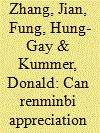

|
|
|
| 2 |
ID:
065486
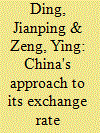

|
|
|
|
|
| Publication |
Sep-Oct 2005.
|
|
|
|
|
|
|
|
|
|
|
|
|
|
|
|
| 3 |
ID:
068990


|
|
|
| 4 |
ID:
081894


|
|
|
|
|
| Publication |
2008.
|
| Summary/Abstract |
China's sectoral trade composition, product quality mix, and the import content of processing exports have all changed substantially during the past decade. This has rendered trade elasticities estimated using aggregate data highly unstable, with more recent data pointing to significantly higher demand and price elasticities. Sectoral differences in these parameters are also very wide. All this suggests greater caution should be exercised when using historical data to simulate the response of China's economy to external shocks and exchange rate changes. Analyses based on models with estimated coefficients largely representative of China in the 1980s and 1990s are likely to turn out to be wrong, perhaps even dramatically.
|
|
|
|
|
|
|
|
|
|
|
|
|
|
|
|
| 5 |
ID:
130973
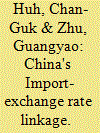

|
|
|
|
|
| Publication |
2014.
|
| Summary/Abstract |
This paper examines how the China-bound exports of Japan and Korea are related to exchange rates, motivated by the fact that processing trade makes up a large proportion of China's trade, and that Japan and Korea are the leading source countries for processing imports. Because processing imports are inputs for exports, the link between such imports and China's exchange rates are ambiguous. We estimate export functions that include China's RMB real effective exchange rates (REER) along with bilateral real exchange rates (BRER) using Johansen's cointegration method and find that the RMB REER significantly affects Japanese and Korean exports to China, even more so than BRER in most cases examined. These two exchange rates appear in the export equations with opposite signs. Subsequently, we use the estimated model to illustrate the importance of accounting for a concurrent change in BRER when analyzing the effects of a hypothetical RMB revaluation on China's trade balances despite the apparently weak imports-BRER linkage.
|
|
|
|
|
|
|
|
|
|
|
|
|
|
|
|
| 6 |
ID:
064984
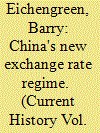

|
|
|
| 7 |
ID:
105076
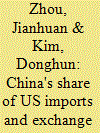

|
|
|
|
|
| Publication |
2011.
|
| Summary/Abstract |
The present paper investigates the effect of China's share of US imports on the aggregate-level exchange rate pass-through to US import prices over the period from January 1999 to December 2008. The paper also focuses on the post-reform period, after 2005, allowing greater flexibility of the RMB to explore the change in the role of the Chinese import share in determining the trend in the US exchange rate pass-through. Evidence reveals that China's share of US imports has a negative effect on the exchange rate pass-through. However, this negative effect has been moderated to a negligible level since China's exchange rate reform. An important implication is that the exchange rate flexibility of the RMB has been raised to a significant level may no longer cause distortion in the US competitive environment and prevent the USA from adjusting current accounts.
|
|
|
|
|
|
|
|
|
|
|
|
|
|
|
|
| 8 |
ID:
068975
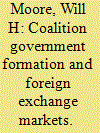

|
|
|
| 9 |
ID:
068009
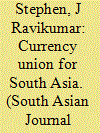

|
|
|
| 10 |
ID:
067280


|
|
|
| 11 |
ID:
054146
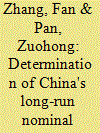

|
|
|
| 12 |
ID:
124399
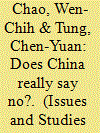

|
|
|
|
|
| Publication |
2013.
|
| Summary/Abstract |
From 2002, the Chinese government insisted that it would not give in to international pressure to change the renminbi (RMB) exchange rate regime. The main question asked in this paper is whether the Chinese government did resist this pressure from early 2002 to mid-2008. Judging from Chinese official documents, records released after bilateral meetings between the United States and China, testimony given by U.S. officials in the U.S. Congress, Chinese government policy statements, and measures related to the RMB exchange rate, we conclude that, in addition to economic and domestic factors, China's exchange rate policy was indeed influenced by American political pressure, and that this pressure led to reform of the RMB exchange rate regime and the widening of the floating band of the RMB exchange rate.
|
|
|
|
|
|
|
|
|
|
|
|
|
|
|
|
| 13 |
ID:
076909
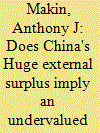

|
|
|
| 14 |
ID:
143527
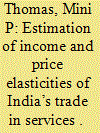

|
|
|
|
|
| Summary/Abstract |
India’s international trade in services benefited immensely from the change in policy stance from import substitution to export promotion in the post-1991 period. Services trade received a further boost when India became signatory to the World Trade Organization (WTO) in 1995. This article aims to estimate the income and price elasticities of India’s services trade during the post-WTO period, using the autoregressive distributed lag (ARDL) approach to cointegration, for the time period starting from 1996–97 Q1 (Quarter 1) to 2011–12 Q4 (Quarter 4). This study finds that the long-run income elasticity of services export is quite high and statistically significant, when the gross domestic product (GDP) of the Organisation for Economic Co-operation and Development countries is taken as proxy for GDP of importing countries. However, the price elasticity of services export is found to be statistically insignificant. In case of services import, both the income and price elasticities of demand are found to be statistically significant, and services import is found to be more responsive to income than relative prices. The implications of the empirical findings for India’s current account deficit are also explored.
|
|
|
|
|
|
|
|
|
|
|
|
|
|
|
|
| 15 |
ID:
152758
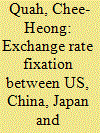

|
|
|
|
|
| Summary/Abstract |
This article assesses the feasibility of exchange rate fixation among the largest economies today, namely, the US, Japan, China and Germany/Eurozone, by reviewing variables according to the optimum currency areas framework. The hypothesis is that with greater interconnectedness in general through time there should be greater convergence in the monetary integration dimensions. The period examined spans from 1980 to 2012, an over-30-year period, encompassing the recent episode of global contraction. While the findings are mixed, economically they seem to suggest a general trend towards greater compatibility or at least one which is not in serious contradiction to exchange rate fixity, particularly for the US and Eurozone.
|
|
|
|
|
|
|
|
|
|
|
|
|
|
|
|
| 16 |
ID:
065485


|
|
|
|
|
| Publication |
Sep-Oct 2005.
|
|
|
|
|
|
|
|
|
|
|
|
|
|
|
|
| 17 |
ID:
095026
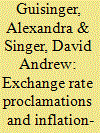

|
|
|
|
|
| Publication |
2010.
|
| Summary/Abstract |
If governments choose economic policies that often run counter to their public commitments, are those commitments meaningless? We argue that government proclamations can be critical in signaling economic policy intentions. We focus on the realm of exchange rate policy, in which countries frequently implement an exchange rate regime that differs from the officially declared regime. We argue that the official exchange rate regime is one of the most important signals of a government's economic policy preferences. When a government makes a de jure public commitment to a fixed exchange rate, it sends a signal to domestic and international markets of its strict monetary-policy priorities. In contrast, a government that proclaims a floating exchange rate signals a desire to retain discretion over monetary policy, even if it has implemented a de facto fixed rate. We use data on 110 developed and developing countries from 1974 to 2004 to test two hypotheses: first, that governments that adopt de facto fixed exchange rates will experience less inflation when they back up their actions with official declarations; and second, that governments that abide by their commitments-as demonstrated by a history of following through on their public declarations of a fixed exchange rate regime-will establish greater inflation-fighting credibility. Within developing countries, democratic institutions enhance this credibility. Results from fixed-effects econometric models provide strong support for our hypotheses.
|
|
|
|
|
|
|
|
|
|
|
|
|
|
|
|
| 18 |
ID:
097720


|
|
|
|
|
| Publication |
2010.
|
| Summary/Abstract |
Theory and empirical evidence show that low inflation is a precondition for economic growth. Independent central banks and fixed exchange rates are institutional mechanisms that help keep inflation low by lending monetary policy credibility to governments. However, the two institutions are commonly analyzed as substitutes that tie the hands of inflation prone governments. Thus, the literature has difficulties describing why governments would adopt both institutions and the interaction between them. This paper presents a model that allows policymakers the simultaneous choice of monetary institutions and shows that imperfectly credible institutions will overlap: when exchange rates are fixed but adjustable and central bank independence is not fully ascertainable, governments choose both institutions. More generally, the paper generates hypotheses about the conditions that make fixed exchange rates and independent central banks complements or substitutes, thus contributing to an explanation of the diversity of global monetary institutions in the post-Bretton Woods period.
|
|
|
|
|
|
|
|
|
|
|
|
|
|
|
|
| 19 |
ID:
065763


|
|
|
| 20 |
ID:
118178


|
|
|
|
|
| Publication |
2012.
|
| Summary/Abstract |
Can monetary policy, and the exchange rate, affect military capability? If weapons systems are purchased on international markets, then a depreciating currency can reduce the import of arms, affecting the relative capabilities of military rivals. In this research note, we analyze the demand for arms imports using an error correction model. We show that arms are a "normal" good, with the quantity demanded directly related to price and with exchange rates serving as an instrument for price movements that are normally unobserved. Such price movements are increasingly important given currency volatility and a reliance on imported technology.
|
|
|
|
|
|
|
|
|
|
|
|
|
|
|
|